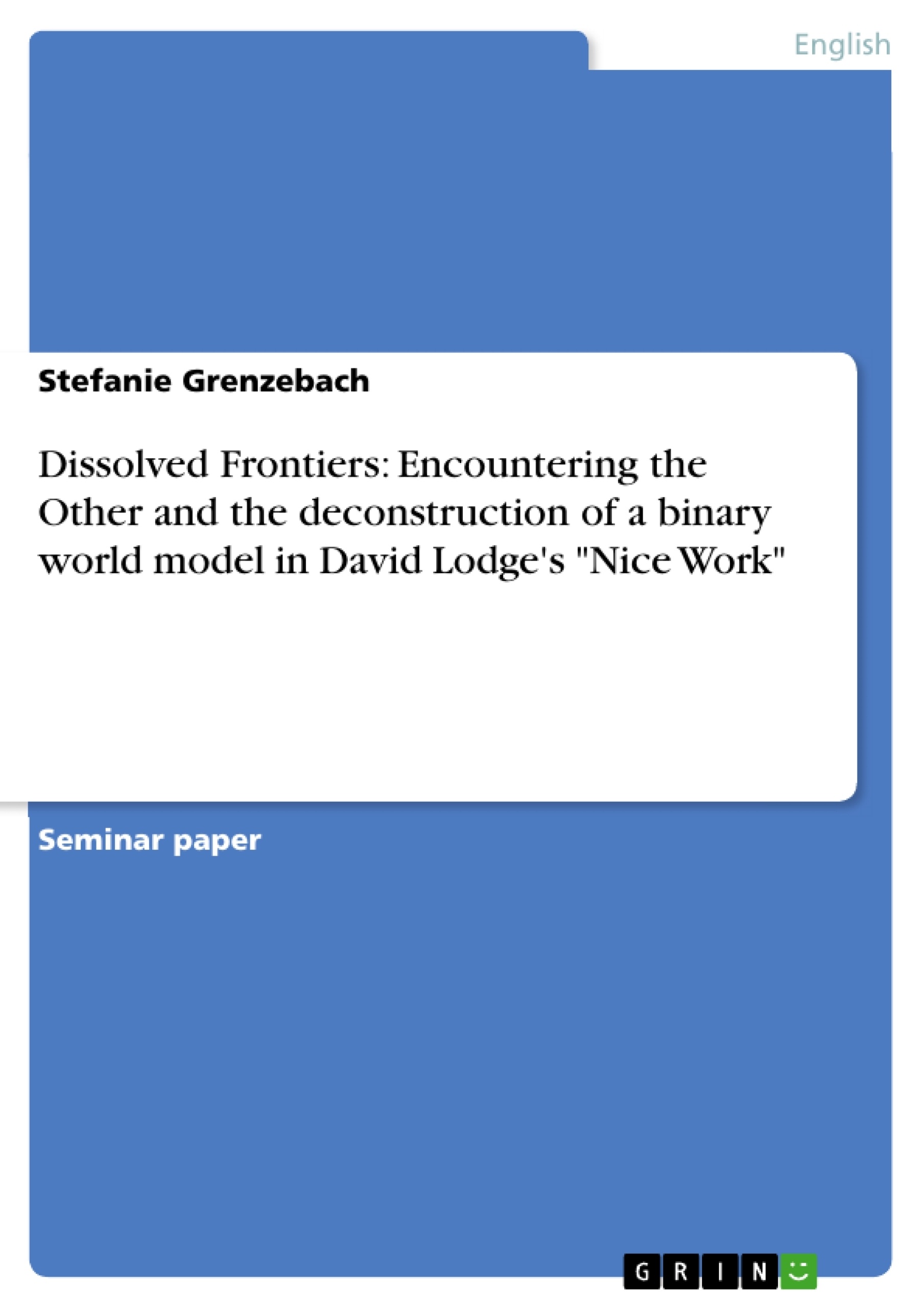In David Lodge's "Nice Work", space constitutes the important aspect of structuring the world of Rummidge and its characters. The novel is set up in a twofold structure of space: Industry, represented by Vic Wilcox (MD of Pringle's engineering), and Academia represented by Dr. Robyn Penrose (English Lecturer at the University of Rummidge). This division does not only imply a geographical but also a social dimension, expressed by an apparent textual structure promoting at first glance a static division between the superiority of male/industry/economic capital and an inferior counterpart of female/university/ cultural capital.
This paper analyses the structure of binary oppositions in "Nice Work" and reveals the potential of discovering another sphere of living based on Lotman's theory of space. In its interpretation, it further calls structuralism into question and concludes with a deconstructive interpretation of the male/female dichotomy .
Inhaltsverzeichnis (Table of Contents)
- Introduction
- Other and self
- The symbolic division of space according to Lotman
- A geographical division in Nice Work
- A social division in Nice Work
- Male/female power-relations in Nice Work
- Work and private life of Robyn and Victor
- Crossing boundaries: The 'Shadow Scheme'
- Discovering similarity:
- Binary oppositions called into question
- Encountering Otherness: A self-reflexive discovery
- Structure of male dominance called into question
- "Assimilating difference" revisited
Zielsetzung und Themenschwerpunkte (Objectives and Key Themes)
The aim of this paper is to examine the role of space and the concept of the Other in David Lodge's novel Nice Work. By analyzing the binary oppositions and their deconstruction throughout the text, the author seeks to shed light on the complex interplay of gender, social class, and power relations within the novel's setting of Rummidge.
- The construction of Otherness through binary oppositions
- The spatial division of the novel's world
- The role of gender and power in shaping social interactions
- The deconstruction of traditional binary models
- The process of familiarization and overcoming prejudices
Zusammenfassung der Kapitel (Chapter Summaries)
- Introduction: This chapter introduces the novel's setting, the "colliding worlds" of industry and academia, and the central characters, Robyn Penrose and Victor Wilcox. It also highlights the apparent division between male/industry/economic capital and female/university/cultural capital.
- Other and self: This chapter discusses the concept of binary oppositions and the role of Otherness in constructing meaning and cultural identity. It explores the "privileged" position of one term over the other and the consequences of this distinction for social inclusion and exclusion.
- The symbolic division of space according to Lotman: This chapter examines how Lotman's theories of space apply to the structure of the novel. It explores the concept of a "räumliche Trennlinie" (spatial dividing line) and its significance in creating meaning in the text.
- A geographical division in Nice Work: This chapter analyzes the geographical separation between industry and academia in Rummidge. It explores the "classificatory frontier" between these two worlds and how they are represented by the protagonists, Robyn and Victor.
- A social division in Nice Work: This chapter discusses the social division between industry and academia as it is reflected in the novel. It examines the contrasting ideologies, values, and lifestyles associated with these two settings.
- Male/female power-relations in Nice Work: This chapter focuses on the dynamics of power and gender relations in the novel. It explores how the "surface structure" of the text, which appears to promote male dominance, is challenged by Robyn's intrusion into the male-dominated world of industry.
- Work and private life of Robyn and Victor: This chapter examines the contrasting lives and experiences of the two protagonists. It highlights their different perspectives and how their interactions challenge traditional notions of gender roles and social expectations.
- Crossing boundaries: The 'Shadow Scheme': This chapter explores the "Shadow Scheme," a secret project undertaken by Victor, and its implications for the relationship between Robyn and Victor. It highlights how this scheme functions as a catalyst for boundary-crossing and a blurring of the lines between industry and academia.
- Discovering similarity: This chapter delves into the process of familiarization and the discovery of similarities between Robyn and Victor. It examines how they begin to understand and appreciate each other's perspectives, challenging the initial binary oppositions that separated them.
Schlüsselwörter (Keywords)
The main keywords and focus topics of the text include: binary oppositions, Otherness, space, gender, power relations, social class, industry, academia, deconstruction, familiarization, prejudice, and David Lodge's Nice Work.
- Quote paper
- Stefanie Grenzebach (Author), 2011, Dissolved Frontiers: Encountering the Other and the deconstruction of a binary world model in David Lodge's "Nice Work", Munich, GRIN Verlag, https://www.grin.com/document/177702



